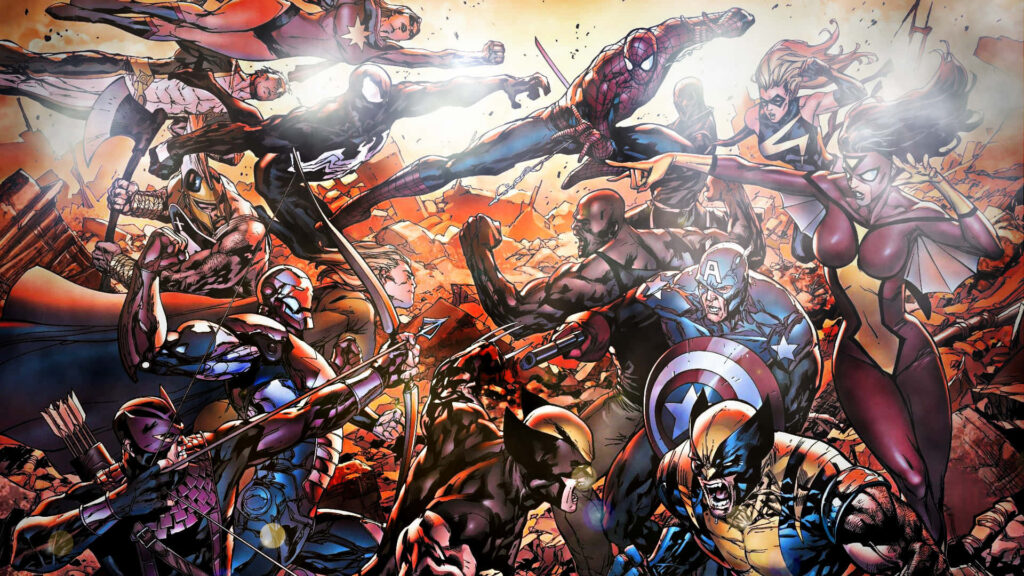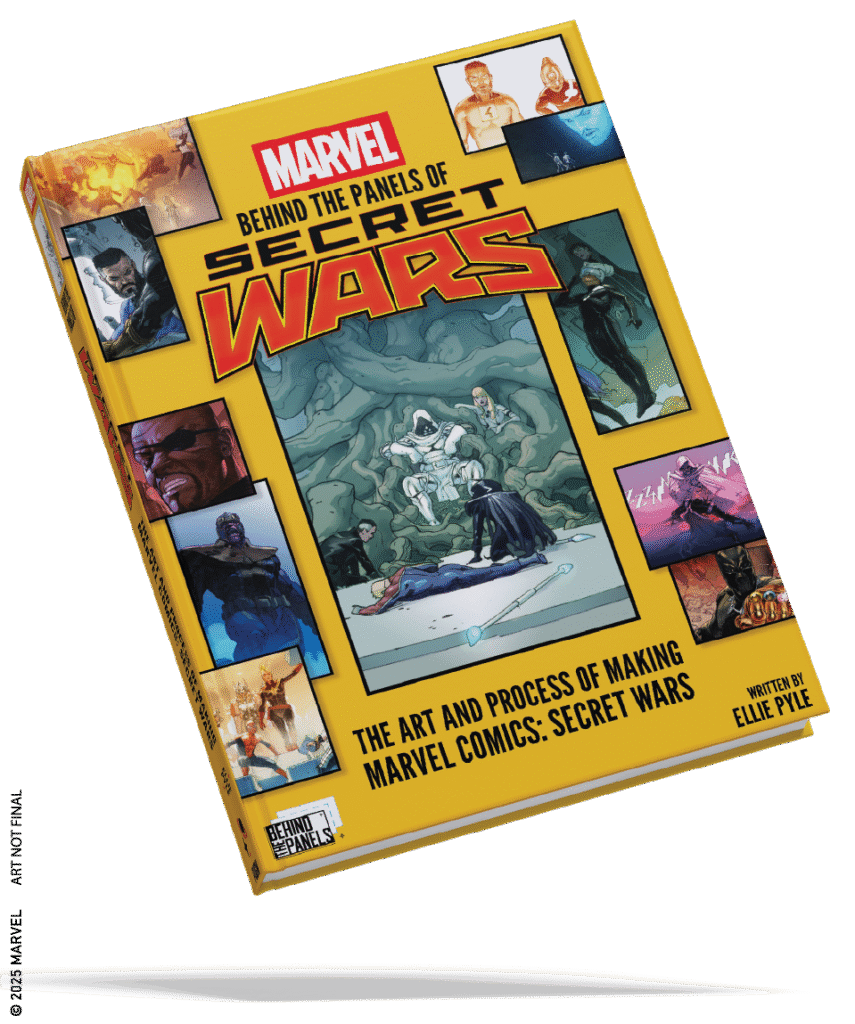Mason Rabinowitz knows how to make a book hit. As Director of Publishing Operations at Pan Universal Galactic Worldwide, he helped shape Marvel: Behind The Panels of Secret Wars into a 300 page experience that moves you through the inner workings of a major comics event. Working from Ellie Pyle’s massive archive of interviews, artwork, and creator insights, Rabinowitz helped turn a mountain of material into a sharp, visually driven deep dive into Marvel’s modern epic.
With a background that includes work with Disney, Top Cow, and Golden Apple Comics, Rabinowitz brings a storyteller’s instincts to Secret Wars. His goal was simple: present one of Marvel’s biggest events with the impact and creative fire it deserves.
Action A Go Go sat down with him to talk about editing at scale, choosing from hundreds of never before seen images, and capturing the controlled chaos behind the destruction and rebirth of the Marvel multiverse.
Let’s go!
AAGG: You are the architect behind the architecture. How did you take Ellie Pyle’s mountain of interviews and notes and turn it into something that reads like a visual experience rather than a textbook?
Rabinowitz: Ellie is too talented and too much fun for her work to ever feel like a textbook, at least the ones I had in school. But I understand the question and the key is that we all understand that comics are a visual medium. We have a lot more text than you would see in a standard art book, but we still have tons of incredible art we are excited to show, from early process work to final pages.
AAGG: Editing a 300 page art book is not for the faint of heart. What was the toughest part of balancing story, art, and flow without losing the reader in the spectacle?
Rabinowitz: The art for Secret Wars was spectacular, especially Esad Ribic’s work on the main series, so I think it is totally reasonable for a fan to open this book for the first time and just flip through the pages and enjoy the spectacle. Then they can dive in and discover the stories and process behind it.
AAGG: With hundreds of images from Marvel’s vaults included, what is the selection process like: instinct, emotion, or pure curatorial discipline?
Rabinowitz: Marvel has been an amazing partner sharing the actual working files for the series, and we have gotten so much additional content from writers, artists, and editors who worked on the book that it would be impossible to share every cool thing. Some of it is pure instinct. If we see something incredibly cool, we try to include it, but we really let the stories and anecdotes from the creators guide the choices so the text and art work together to tell the story.
AAGG: Every great editor knows when to cut and when to let a moment breathe. Was there a quote or insight from the Marvel contributors that simply had to stay in?
Rabinowitz: There are some great insights from the creative summit where everyone met to plan the entire event that will really bring fans into a part of the process they rarely get to see. Most are too long to share here, but Tom Brevoort had one rule that applies to any comic and is something the Secret Wars tie ins really nailed. He said, “A good tie in is a compelling story, regardless of whether or not you read anything else.”

AAGG: The tone of Behind the Panels balances reverence with raw creative energy. How did you lock in that balance?
Rabinowitz: I love that description. Beyond presenting Secret Wars as the incredible work of art that it is, we wanted to highlight, celebrate, and document the astonishing passion, work, and creative energy that so many people poured into making it a reality.
AAGG: Collaboration is the true superpower in publishing. How did you and Ellie Pyle keep the project aligned with PUGW’s editorial vision while letting each other’s strengths shine?
Rabinowitz: Collaboration is absolutely key. At PUGW, our creative vision for Behind The Panels begins with finding the right creator for the project, and we were very lucky to get Ellie. Then we let them talk to the creators and find the stories, anecdotes, and insights that shape the book. Shaping that material is a collaborative process, but our focus is always on telling the story of how these creators made this series in the most interesting and exciting way.
AAGG: From an editorial point of view, what makes Secret Wars stand apart from every other Marvel event?
Rabinowitz: The first thing that stands out is the sheer scope of the story and the massive undertaking of ending every title in the Marvel and Ultimate lines, launching an entirely new line of tie ins during the event, then relaunching everything afterward. To even attempt that, let alone deliver it as well as they did, is an accomplishment. But what stands out more every time I revisit Secret Wars is that while it has universe shattering moments, it is ultimately a story about characters and their emotional journeys.
AAGG: PUGW wants to give comic art the same weight as cinema. What does that look like in practice?
Rabinowitz: Comics are an art form and a storytelling medium equal to prose, film, or television. Behind The Panels is not about elevating comics to the level of film. It is about taking inspiration from the behind the scenes interviews and details you used to get in Special Edition DVDs or classic making of books and bringing that spirit to comics.
AAGG: You have seen the gears turning behind one of Marvel’s biggest modern epics. What will surprise fans most about how Secret Wars was actually made?
Rabinowitz: Just how much those gears are being hand turned by people. You cannot help but be awed by the sheer energy, passion, and creativity of the contributors and their love for comics.
AAGG: You lived in Battleworld for months putting this together. What did you personally take away about collaboration, chaos, and creating something this big?
Rabinowitz: The biggest thing is the importance of fun. Creating a space where people can enjoy doing their job is vital, and it reminded me to have fun doing mine. Many creators said this was some of the most fun they had ever had working on a big crossover, and a lot of that comes from the way Hickman structured the event so people could do something they were excited about that still connected to the overall story. It took an incredible amount of work and talent, but the fun is a huge part of why it works so well.
END OF INTERVIEW

If you want to understand how one of Marvel’s most ambitious events came to life, Mason Rabinowitz helps offers a rare and generous look behind the curtain. Marvel: Behind The Panels Of Secret Wars captures the work, artistry, and passion that fuel a story of this scale. It is going to be essential reading for anyone who loves comics or the craft of building fictional worlds.
You can support the Kickstarter for Marvel: Behind The Panels Of Secret Wars right here!

